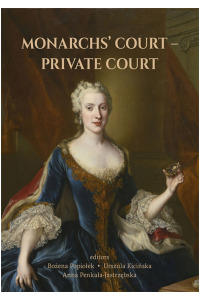MONARCHS’ COURT – PRIVATE COURT. The Evolution of the Court Structure from the Middle Ages to the End of the 18th Century
Autor: Bożena Popiołek, Urszula Kicińska, Anna Penkała-Jastrzębska
This monograph provides insights into European courtly circles from the perspective of structural and cultural changes that took place both in the reigning monarch’s courts and in private circles from the Middle Ages to the end of the 18th century. Regardless of the patron or patroness, the court was undoubtedly an interesting administrative, economic, and cultural structure, exerting a strong influence on the organization of European society in the pre-industrial era. The structure of the European ruling courts fluctuated constantly: their organization, their members, and the role they played changed. Not only was the court an important element of state administration and the administrator of offices, goods, and means, but also the creator of new cultural values and the environment where the youth was educated, where social advancement was possible, and where clerical and political careers flourished.
To a large extent, their size, members, and etiquette depended on the financial capabilities, as well as on the political structures of the countries in which they operated. With time and the development of new structures in the royal or aristocratic courts, which were the conveyor of elite values as well as new aesthetics and fashion, the court would become not only an element of authority, but also of prestige, as well as an expression of wealth belonging to a specific social group characterized by a coherent system of signs, gestures, and cultural codes, which constituted a community of educational models, and ceremonies.

Wszyscy ludzie Elżbiety Sieniawskiej
Bożena Popiołek, Janusz S. Nowak
Monografia stanowi niezwykle interesujące ujęcie obszernego tematu, który był dotychczas badany w stopniu fragmentarycznym. Autorzy proponują nie tylko wyczerpującą analizę urzędników, oficjalistów dworskich, rzemieślników, kupców oraz artystów skupionych... więcej »

Turystyka wobec nowych wyzwań. Współczesne kierunki kształcenia w akademickiej i szkolnej edukacji turystycznej
Bożena Popiołek, Natalia Bursiewicz, Urszula Kicińska, Anna Penkała-Jastrzębska (red.)
Książka zawiera czternaście artykułów, rozłożonych w dwóch częściach. Pierwsza zatytułowana jest Współczesne trendy w edukacji turystycznej i krajoznawczej, druga – Potencjał edukacji muzealnej i regionalnej. Obszerny wstęp ukazuje złożoność badań nad turystyką... więcej »

W kręgu rodziny epok dawnych. Przemoc. Seria: Prace monograficzne 967
Bożena Popiołek, Agnieszka Chłosta-Sikorska, Marcin Gadocha
Książka stanowi zbiór 24 tekstów, których motywem wspólnym jest przemoc w rozmaitych odmianach. Zakres chronologiczny opracowań jest bardzo szeroki. W tomie można spotkać się z bardzo zróżnicowaną perspektywą badawczą. Część autorów skupia się na ujęciu wręcz... więcej »

W tym osieroconym stanie. Pozycja wdowy w społeczeństwie szlacheckim w Rzeczypospolitej (od schyłku XVII do połowy XVIII wieku). Seria: Prace monograficzne 1001
Urszula Kicińska
Pierwsza w Polsce monografia poświęcona przedstawieniu miejsca wdowy w społeczeństwie szlacheckim dawnej Rzeczypospolitej od końca XVII do połowy XVII wieku. Czytelnik może lepiej poznać relacje wdowy ze światem. Ukazano wdowią codzienność, rozmaite troski... więcej »


